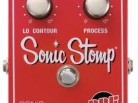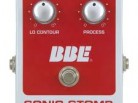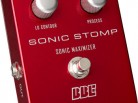A pedal I got recently after my son's praise was this BBE Sonic Stomp. I've heard BBE's rack mount sonic maximizers so I wondered if this pedal could capture what one of those does.
How does it work?
What's a sonic maximizer? I'll let this quote from BBE's website try to explain it:
"Sonic Stomp’s application of the BBE technology is just like its big brothers, using frequency-dependent time alignment with integrated amplitude compensation. What’s all that about? Simply put, it helps a speaker more faithfully reproduce the signal so more of the nuance and detail is revealed. Sonic Stomp is not an effect but a tool to allow more of your tone to reach the ears of your audience – and yours."
So basically BBE's sonic maximizer technology uses
1. A frequency-dependent time alignment and
2. Amplitude compensation.
Frequency dependent time alignment makes sense - some sound waves travel slower than others and all sound waves are slower than most high energy equipment that produce them. So if an amp produces slow moving bass frequencies, faster moving mid frequencies, and even faster treble frequencies the faster frequencies are produced from the speaker first. Play a full chord and from enough of a distance from the speaker you may notice the accentuation of the lower frequencies comes later than the higher frequencies.
Amplitude compensation. Basically, to me, this is an EQ section. You can increase mid, treble, or bass frequencies. But the way BBE achieves this is more than just a standard EQ pedal. One thing I noticed while playing with this peda,l and you'll probably notice in a lot of the videos on their site, is that the mids are really brought forward in the sound. The total sound is boosted but mids really are accentuated. The guitar is a mid instrument so this is a good idea. Even 'modern' heavy sounds which use a mid scoop can benefit from more mid just before the amp cuts it with a mid scoop. Somewhere in all this the initial attack of the notes are being accentuated. Normally a sound will look like a wave - low initial sound at the attack which goes up and then drops off again. By boosting the initial attack the notes are more distinct from each other and the human ear really likes that effect.
How well does it work?
A lot of this is subjective. I was a little underwhelmed but my son and other guitar players swear by this idea. I like the effect of the pedal, don't get me wrong. It improves the clarity of the notes and the Lo Contour knob really can adjust the amount of bass frequencies. The Process knob seems to affect treble frequencies like the Lo Contour affects the bass. What my ear really likes is the initial attack improvement but here's the rub:
As far as improving the attack of notes an overdrive pedal can do that. Set low the attack is improved without changing the overall sound. Boosting the mids an EQ pedal can do that. So we are left with the frequency dependent time alignment claim. The only way to test that would be to use the effect in a large room where it would be more noticeable It just so happens my son plays in this type of room all the time and he swears that the sound all over the room is improved with this effect.
Conclusions
My ear likes what it hears with this pedal. All the frequencies seem to sound better and the mids are really improved. I think really good sound can be produced without this pedal but at lower settings it still improves the sound without changing it too much. I got a chance to repair one right after I bought one so I cracked them both open and compared them. One had a blue LED and the other green. The only difference between the two besides the LED were that different brands of resistors were used between the two pedals. They both sounded the same to me so I don't think this was a manufacturing run change trying to improve anything. BBE has also changed the outside look of the pedal more than once. Again I think its just marketing and not anything to do with what is inside.
I'd say the pedal's improvement of initial attack without boosting the signal strength too much is a good idea. Give it a spin and see what you think. More often than not I think people will add this pedal to their boards after a test drive. If you don't care for the effect then an EQ pedal would be a better idea for you. You can get the same mid accentuation. As for the time alignment of the frequencies the different speed of these frequencies naturally is part of what our ear expects to hear. Changing that my not be very noticeable but I wonder if it becomes an annoying effect over a long concert. Odds are people I've heard live have used this effect and I didn't mind it so it isn't but like everything with sound the argument could be made that naturally aligning sound frequencies is a sound some people prefer.
All this comes down to taste. I like the sound I got with this pedal. Would I go out of my way to add this pedal to my board? Probably not. But to each his own - see if this is the thing you've been looking for in your sound.
BBE Sonic Stomp Sonic Maximizer
By
Victor Oshiro |
Posted
May 1, 2013
at
10:05AM
Description
Rating
Summary
Pros
Pleasing effect
May improve sound in large venues
May improve sound in large venues
Cons
A lot of the changes this pedal claims to do can be done with other pedals that might be on your board right now
Latest news
-
Could the Computer Age Have Begun in Victorian England?
By Victor Oshiro
Posted October 31, 2022 at 11:28AM -
Is there a savant inside all of us?
By Elena Ananieva
Posted October 4, 2022 at 12:17PM -
Teaching an old dog new tricks: How to fix Microsoft
By Oleg Mitskaniouk
Posted September 25, 2022 at 12:45PM -
How the brain filters bad news
By Oleg Mitskaniouk
Posted September 25, 2022 at 12:30PM
Latest reviews
-
Bose 901 Saga
By Oleg Mitskaniouk
Posted November 22, 2022 at 04:22PM -
Kwikset 909 Electronic Deadbolt
By Victor Oshiro
Posted November 7, 2022 at 09:28AM -
ViewSonic SC-U25 VDI Client
By Victor Oshiro
Posted October 31, 2022 at 01:30PM -
AEE S71T Plus
By Oleg Mitskaniouk
Posted October 26, 2022 at 01:38PM
.jpg)












